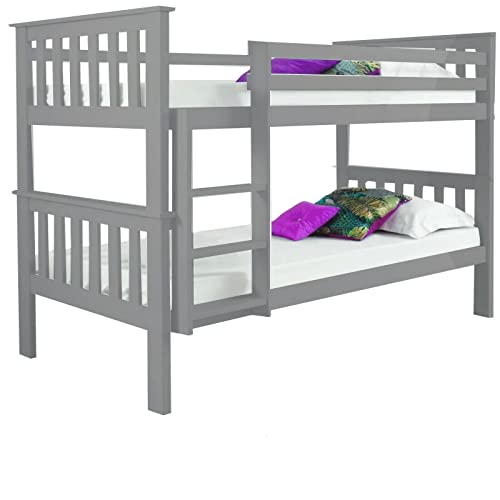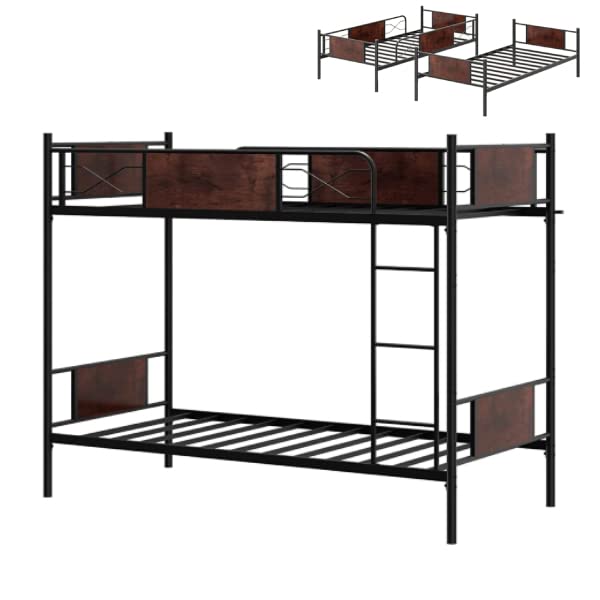Bunk Single Beds Techniques To Simplify Your Daily Life Bunk Single Be…
페이지 정보

본문
 Bunk Single Beds
Bunk Single BedsBunk beds can make a massive difference to the room of a child. They can assist in keeping their rooms tidy, clean and organized by giving them a place to store books, toys and other bits and pieces.
They can also create an uninviting, less private space. To overcome this, select furniture that offers the ability to design and style your own.
Size
Bunk beds are a space-saving solution for sleeping more than one person in the same room. However, choosing the right size is essential for safety and comfort. To avoid mobility issues bed dimensions must be aligned with the room size and ceiling height. The side rails of the bunk bed need to be tall enough to support mattresses and should attach firmly to the frame.
Bunk single bunk bed with trundle beds are typically smaller than typical single bed sizes however, they are still suitable for adults to use. This allows you to pick a mattress that is the right thickness for your body type and sleep needs. A mattress that is thinner is often preferred by younger kids on the top bunk as it is easy to move in and out.
There are a few choices for the size of the mattress on a bunkbed, including twin over futon and twin over full. Both of these configurations are perfect for parents that have children of various age groups. Twin over full bunk beds have queen-sized mattress on top, and a large mattress on the bottom. This is a popular option for families with children who are at similar ages and heights. Futon bunks are another option that include the standard top bunk as well as a lower futon that can be adjusted to function as a bed or couch.
You can also opt for an XL full size bunkbed, which is five inches larger than a traditional full mattress. These mattresses are great for teenagers and taller adult single sleepers.
For healthcare facilities that frequently alter their patient demographics and needs, bunk single beds are a great solution for accommodating varying demands for sleep. It is important that you regularly inspect and maintain your bunk beds and single beds to ensure they meet the most stringent safety and comfort standards.
Bunk beds are the ideal solution for healthcare facilities who need to maximize space in a small area. They are durable and offer an excellent value for your budget, since you will reduce space by eliminating the need for additional furniture pieces. Additionally, bunk beds are a great way to encourage collaboration between your staff and patients. This can increase satisfaction of patients and boost positive outcomes.
Style
In addition to the dimensions of single and bunk beds, it is important to think about the style you're seeking. For example, metal bunk beds are a great option for establishments that are looking to create a more traditional style without sacrificing durability or strength. They are also less messy than single bunk bed with desk upholstered beds.
On the other hand single beds are typically more suitable for rehabilitation and long-term care facilities, where patient populations are stable and more permanent. They may be less cost effective than bunk beds, but they offer the same level of comfort and safety.
Single beds are also easier to dress than bunk beds. Dressing a twin bed on the ground may be a challenge however hanging it from a ladder and trying to get it in it into a bed is a new challenge! Bunk beds require a certain degree of strength and agility to climb. It can be difficult for young children or those with mobility issues.
Single beds can be decorated in a variety of ways. This gives the facility manager greater flexibility and allows them to create a more personalized space for guests. They can also be placed with other furniture pieces to make a room appear more comfortable and inviting. A bunk bed, for instance is a great option to pair with a daybed or desk to maximize the available space.
In the end, it's the facility's management to decide what bed layout is best suited to their particular needs and population. Consider the factors that are crucial to your organization to make the right choice and choose the most suitable bed for your patients.
Whatever kind of bed you decide to buy, be sure to regularly inspect and maintain them to ensure that they're in good condition and are functioning correctly. This can reduce the risk of liability and extend their lives. Journal of Facility Management states that regular maintenance can cut repairs costs by 20 percent. Bunk beds and individual beds are both excellent choices to furnish facilities for behavioral health. However it is essential to take into account your specific patient demographics as well as the size of your facility in order to decide which option is most suitable for your particular program.
Safety
It's for a child's bedroom or a facility for behavioral health, bunk single beds offer numerous advantages. They can increase space and offer more storage but also pose safety concerns due to their size and height. Bunk beds require an access ladder to the upper bed and kids may be enticed to play on the bed or climb on the ladder. To ensure that everyone is safe it is essential to teach your children to use the stairs properly and ensure that they are secured.
Guard rails are another important safety feature for bunk beds. They are designed to prevent falls. They should be placed at about 16cm from the surface of the mattress and their gaps should be no larger than 7.5cm. There's a wealth of details on how to install your guard rails, and also ensure that they're meeting safety standards by examining the guidelines of the manufacturer.
Bunk bed safety is also dependent on the right bedding. Only use mattresses that meet safety standards and fit snugly on the frame. It is also recommended to regularly clean the mattress and its support system in order to minimize the chance of entrapment and injury.
Ladders or stairs that are used to get to the top bunk must be sturdy and installed securely to avoid accidents. They should be set at an angle that blocks children from climbing over or under guardrails. Handrails should be able to be gripped easily. They should also be free of toys and clutter so that children of all ages will not be enticed to play with them.
Finally, you must be aware of the challenges to cleaning that bunk beds can cause and implement regular hygiene protocols to keep hygiene at a high level. According to a research study published in Infection Control Today bunk beds may require 20% more time for cleaning than single beds. Following these tips will help you reduce the risk of bunk beds while providing your patients with a cozy and warm environment.
Convenience
Bunk single beds offer an easy solution for facility managers to meet space efficiency, patient safety and comfort needs. They are available in a variety of sizes to meet the needs of different patients, and their simple design makes them easy to clean and maintain.
Safety Increased Single beds have higher level of stability than bunk beds and need less structural components. This reduces the risk of falling, which is a significant concern in healthcare facilities. Their simple design and low profile make them more accessible for staff, reducing the risk of injury.
Efficiently utilizing vertical space in the room is a crucial aspect in a variety of human services and behavioral healthcare settings, where floorspace is in short supply. bunk single bed bunks beds (mouse click the up coming webpage) allow facilities to accommodate more patients in the same space, which can result in cost savings. This is especially beneficial for high-density buildings or spaces that are tight with a little floor space.
The beds are designed to give the greatest flexibility in a room, since they can be separated into two individual single beds when the child is old enough or no longer needs to share a room. These beds are perfect for families that anticipate changes to their children's sleeping habits. They can also help reduce clutter and provide more storage space.
The lower platform can be transformed into a futon during the daytime, maximizing space in a bedroom or apartment. Certain frames are also set in an L-shape so that the lower platform can be used as a couch while a mattress is positioned on the top. This provides additional flexibility and convenience. Bunk beds can also be found with storage built-in to keep the room tidy and organized. Bunk single beds are typically more expensive than standard single beds, however they're more cost-effective in the long term due to lower maintenance costs and extended lifespans. They're also simple to disassemble and assemble and are ideal for quick relocations and reorganizations. This feature is important for facilities that need to organize rooms often to accommodate the changing demographics of patients or clinical needs. The beds are also easy to keep clean and tidy which aids in effective infection control practices.

- 이전글15 Up-And-Coming Fiat Punto Key Replacement Bloggers You Need To Be Keeping An Eye On 24.11.09
- 다음글Лучшие методы онлайн-казино для вас 24.11.09
댓글목록
등록된 댓글이 없습니다.

